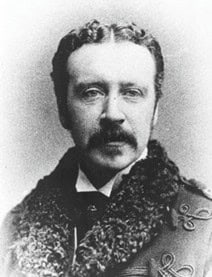Colonel D.T. Irwin’s Tunic
Throughout centuries, armies and militia have always used standardized dress to express identity and belonging. Britain’s Royal Artillery wore blue with scarlet facings and embellishments of embroidery and feathers – a look that encountered many changes over the years but kept its customary colours in the post-Confederation Canadian Militia.
Our museum boasts a tunic dating back to Canada’s early army years. Our collection’s dark blue, gold-trimmed jacket has a scarlet collar, shoulders, and cuffs. Six gold lace loops adorn the breast of the coat with caps and drops on each side with gold-worked olivet buttons for fastening. The epaulettes bear ornate silver-threaded pips of a crown and two stars. More impressive is the original owner of this intricate garment: Great Gunner, Col D.T. Irwin, CMG.

Colonel D. T. Irwin Tunic

Colonel D. T. Irwin
Colonel De la Cherois T. Irwin, born in Ireland, began his military career in London, England, and soon got sent over on exchange to Canada as part of the Royal Artillery. There, Irwin was posted to A Battery, the School of Artillery in Kingston, Ontario and received the promotion of Major in the Canadian Militia. Succeeding Col G.A. French as Commandant of the School of Artillery and as Officer Commanding of A Battery, Irwin worked alongside modern Canadian Artillery founding father and Great Gunner Major-General T. B. Strange. Col Irwin was the first Commanding Officer of the Regiment of Canadian Artillery from 1883 to 1897. He is responsible for critical regimental reorganizations as well as significant improvements in matters of military rations and expansion of the artillery to different locations.
The Staff Officer’s undress jacket is unique compared to the other uniforms we have in our collection dating back to that period. The sleeves showcase gold embroidery much more intricate than the one on the gunner’s uniform, which features a simple Austrian knot. The reason for this difference is that Col Irwin was a Field Officer, and uniforms of the higher ranks were usually more embellished than those of lower ranks.
The RCA Museum is fortunate to possess Col Irwin’s tunic and other uniforms from the same era. These garments offer a glimpse into the early days of the Canadian Militia. Despite all the variations undergone by the military dress over the last century and a half, today’s Canadian Army still considers the uniform an “outward symbol of its commitment, identity and ethos” that members should wear proudly.
